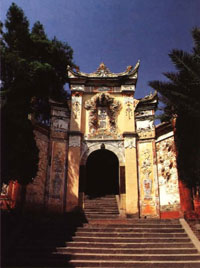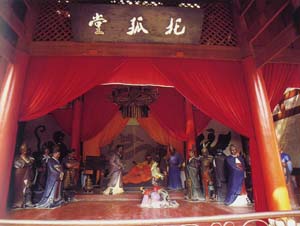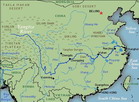2020 Yangtze River Cruise and Ferry Starting from 79 USD p.p.!
Baidi Cheng (White Emperor City)
The local ferry from Fengiie takes
about 20 minutes to reach Baidi Cheng on the
north bank of the river, passing several pagodas
on the surrounding peaks the return trip takes
an hour). Sadly the approach to this historic
site is quite spoilt by a factory and workers'
housing built in the 1970s.
Because of its strategic position
the town was chosen in the first century AD
by Gong Sunshu,  an
official turned soldier, as the site of his
headquarters. The legend goes that in AD 25
white vapour in the shape of a dragon was seen
rising from a nearby well. Taking this as an
auspicious omen, Gong declared himself the 'White
Emperor' and the town 'White Emperor City'.
Remains of the city wall can still be seen on
the hill behind Baidi Mountain. The 12-year
reign of the White Emperor was regarded as a
time of peace and harmony, so after his death
a temple was built to commemorate his reign.
This temple dates back over 1,950 years.
an
official turned soldier, as the site of his
headquarters. The legend goes that in AD 25
white vapour in the shape of a dragon was seen
rising from a nearby well. Taking this as an
auspicious omen, Gong declared himself the 'White
Emperor' and the town 'White Emperor City'.
Remains of the city wall can still be seen on
the hill behind Baidi Mountain. The 12-year
reign of the White Emperor was regarded as a
time of peace and harmony, so after his death
a temple was built to commemorate his reign.
This temple dates back over 1,950 years.
Several hundred steps lead up the
wooded Baidi Mountain. The Western Pavilion
(at one time known as Guanyin Dong) on the slope
is believed to have been occupied by the great
poet Du Fu, who wrote numerous poems at this
site. The pavilion overlooks what Du Fu described
as 'the limitless Yangtze'. Further up the hill
is a stupa, marking the grave of a much--loved
literary monk who served at the temple during
the Qing dynasty (1644--l911).
A red wall with an imposing yellow
dragon-head gateway surrounds the temple complex.
Though the temple was originally dedicated to
Gong Sunshu, the White Emperor, his statue was
removed in the Ming dynasty (l368--l644) and
repla ced
with images of Liu Bei, Zhuge Liang, Guan Yu
and Zhang Fei, heroes of the Shu Kingdom during
the Three Kingdoms period. The present halls
date from the Ming dynasty.
ced
with images of Liu Bei, Zhuge Liang, Guan Yu
and Zhang Fei, heroes of the Shu Kingdom during
the Three Kingdoms period. The present halls
date from the Ming dynasty.
The front hall contains large modern
statues which depict Liu Bei on his deathbed
entrusting his Sons to the care of Zhuge Liang.
To the left is the handsome, winged Observing
the Stars Pavilion (GuanXng Ting), Where a large
bronze bell can be seen hanging in the upper
storey. From this pavilion Zhuge Liang observed
the stars and made accurate weather forecasts
Which helped him plan his victorious battles.
The two Forest of Tablets halls contain several
rare engraved stelae, some of which are over
1,300 years old. The Phoenix Tablet is particularly
finely engraved. The Bamboo Leaf Poem Tablet
is one of only three in China. It is considered
a fine work of art, combining as it does poetry
and calligraphy, for the tablet is engraved
with three branches of bamboo,each leaf forming
the Chinese characters of a poem.

The Wuhou Hall is dedicated to Zhuge
Liang, his son and grandson. The bodies of the
statues are of the Ming dynasty (1368--1644),
but the heads, smashed in the Cultural Revolution
(l966--76), are new. Mingliang Hall is dedicated
to Liu Bei, Who is shown surrounded by four
attendants, as well as the black-faced Zhang
Fei and the red faced Guan Yu on one side, and
Zhuge Liang on the other. Adjoining rooms display
furniture, scrolls, porcelain and other cultural
relics.
In 1987, several buildings were
converted to form a museum displaying the many
cultural relics found within the area, including
two coffins from the Ba culture. One of these
dates back to the Western Han dynasty (206 BC-AD
8).
Fine views of the entrance to Qutang
Gorge can be seen from the temple. As the Three
Gorges Dam begins to take effect, the water
level will rise and Baidi Mountain will become
an island.
At the foot of Baidi Mountain, Yanyu
Rock-over 30 metres (100 feet) long, 20 metres
(66 feet) wide and 40 metres (130 feet) high--used
to be a constant hazard to boats riding the
swift current and heading into the narrow entrance
of Qutang Gorge. Over the ages, countless vessels
perished. In l959 it took a work team seven
days to blow up this gigantic rock.
• BaiDi
Cheng(White Emperor City)
• The
Story Of The Three KingDoms



